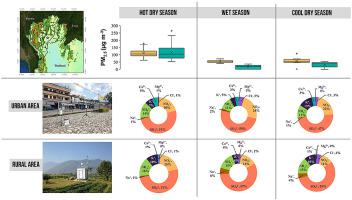Chemosphere ( IF 8.1 ) Pub Date : 2021-08-03 , DOI: 10.1016/j.chemosphere.2021.131803 Sarana Chansuebsri 1 , Pavidarin Kraisitnitikul 1 , Wan Wiriya 2 , Somporn Chantara 2

|
This study aims to investigate ion composition of PM2.5 in various sites and seasons and to identify the main sources on spatial and temporal basis. PM2.5 compositions of two urban and two rural areas in Northern Thailand in 2019 were investigated to distinguish urban traffic and rural open burning sources. During the burning season, average PM2.5 concentrations in rural areas (104 ± 45 μg m−3) were slightly higher than those in urban areas (94 ± 39 μg m−3). Source identification of PM2.5 by cluster analysis during burning season in urban sites and one rural site revealed mixed sources of aged aerosols from biomass burning, traffic and transboundary pollution, characterized by (NH4)2SO4 and KNO3. Only PM2.5 in one rural area (Chiang Dao), where intense open burning activities observed, contained significant KCl level in addition to other compounds. KCl is being used as a tracer for fresh aerosols from biomass burning as opposes to KNO3 for aged aerosols. It was found that KNO3 proportion in total ions increased with PM2.5 concentrations both in urban and rural areas, indicating prominent open burning influences in regional scale. Source identification in other seasons was more distinguishable between urban and rural areas, and more varied depending on local emissions. Urban PM2.5 sources were secondary inorganic aerosols from traffic gas conversion in contrast with rural PM2.5 which were mainly from biomass burning.
中文翻译:

泰国北部农村和城市大气中新鲜和老化 PM2.5 及其离子组成与来源识别的相关性
本研究旨在调查不同地点和季节PM 2.5 的离子组成,并在时空基础上确定主要来源。调查了 2019 年泰国北部两个城市和两个农村地区的PM 2.5成分,以区分城市交通和农村露天燃烧源。在燃烧季节,农村地区PM 2.5 的平均浓度(104 ± 45 μg m -3)略高于城市地区(94 ± 39 μg m -3)。在城市站点和一个农村站点通过聚类分析在燃烧季节期间对 PM 2.5的来源识别揭示了来自生物质燃烧、交通和跨界污染的老化气溶胶的混合来源,其特征是(NH4 ) 2 SO 4和KNO 3。在观察到剧烈露天燃烧活动的一个农村地区(清道)中,只有 PM 2.5除其他化合物外还含有显着的 KCl 水平。KCl 被用作生物质燃烧产生的新鲜气溶胶的示踪剂,而不是 KNO 3用于老化气溶胶。结果表明,无论是城市还是农村,KNO 3占总离子的比例都随着PM 2.5浓度的增加而增加,表明露天焚烧在区域尺度上的影响显着。其他季节的源头识别更能区分城市和农村地区,更多地取决于当地的排放量。城市 PM 2.5来源是来自交通气体转化的二次无机气溶胶,而农村 PM 2.5主要来自生物质燃烧。











































 京公网安备 11010802027423号
京公网安备 11010802027423号